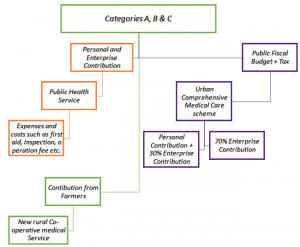China’s Health Care System Case Study Solution
Healthcare financing resources in China
In China, it is to notify that the national healthcare expenditures were amounted to $376.94 billion. The total healthcare expenditures’ share in relation to the per capita expense was $279.7 USD and gross domestic product of china was 5.15%. In early 1990s, the government inputs were 25% whereas the individual out of pocket contribution was 35%, and the private contributions including private medical insurance contributed to 40%. For Chinese hospitals, the balance of the revenue and expenditures can be seen in Appendix D. It is to stipulate that the ultimate surplus comes from the drug sales amounted to RMB 2.65 billion and financial subsidies amounted to RMB 6.00 billion, this in turn indicates low cost charged for medical services to cover the actual cost. Therefore, for the essential medicines, the zero mark-up policy has not been applied yet in the tertiary and secondary hospitals in China, which shows that there was a surplus profits in this area in 2011 After disappearing revenues due to the public hospitals reforms, the hospitals would most likely require financial support from the insurance providers and the government.
Evaluation on China’s Healthcare System:
Recently, the economic growth of China is gradually increasing per year. This results in the better lifestyle of the Chinese residents, but it makes their life stressful,as most of the people in China rely on fast food, which is surely not a nutritious diet, causing many health issues. This has led the government of China to improve the health care programs with an aim of developing worldwide security system of health. This program is based on the evaluation of different factors on the public health such as their lifestyle, environment, and impact of social and economic situations. The development of this program is designed to resolve issues like the problem of chronic diseases, increased cost and inconsistencies in provision of healthcare. The rate of chronic diseases in China has excessively increased as compared to the U.S.
So, the aim of the healthcare system of China is to reduce the rate of chronic diseases and the treatment costs by 2020. Since 2009, a number of steps have been taken by the government of China for the acceleration of healthcare amendments. It has been noticed that China is concerned about the good health of its each resident both in urban and rural areas. As a number of important measures have been taken by the local and central government of China to improve the health care facilities not only in public sectors but also in private sectors. Because of which there has been an increase in the number of private hospital in China by 2015.
Logistics Process:
In China, the people are not satisfied by medical services.High cost, low efficient services and pressure of work in all the hospitals are the major concerns of China. The main issues in the improvement of service levels are the backward management of logistics and a large number of patients.However, technology of modern logistics and the development of information system are being introduced in many hospitals, but the efficiency of services is still significantly low. The reason is that team working on logistics is not well experienced, which has led the sectors of healthcare industry to be in a mess. There are a numbers of steps to bring significant changes in logistic process of healthcare industry.
The operation of logistics should be optimized and the integrative management should be implemented to provide patients with complete services, reducing the healthcare provision issues. In logistics systems and information technology, the implementation of the organic combinations should be done for minimizing the cost of labour. The main important measure for the improvement of logistics operation is the training of logistics managers. The healthcare industry should involve third-party opinion while purchasing the equipment for logistics. These measures are assumed to improve the level of healthcare service in China.(Lu ZHANG, 2015)
APPENDIX
Appendix A - Comparison of infant mortality rates between 1995 and 2011
| Indicator | 1995 | 2000 | 2005 | 2008 | 2009 | 2010 | 2011 |
| Total (1/1000 live births |
36.4 |
32.2 |
19.0 |
14.9 |
13.8 |
13.1 |
12.1 |
| Urban (1/1000 live births) |
14.2 |
11.8 |
9.1 |
6.5 |
6.2 |
5.8 |
5.8 |
| Rural (1/1000 live births) |
41.6 |
37.0 |
21.6 |
18.4 |
17.0 |
16.1 |
14.7 |
| Rural/ urban (ratio) |
2.93 |
3.14 |
2.37 |
2.83 |
2.74 |
2.78 |
2.53 |
China Health Statistics Yearbook 2012
Appendix B - Trends of the morbidity of major non-communicable disease
| 1993 | 1998 | 2003 | 2008 | |
| Heart Disease (cases/ 1000 population | 13.2 | 14.3 | 14.3 | 17.6 |
| Diabetes (cases/ 1000 population) | 1.0 | 3.2 | 5.6 | 10.7 |
| Hypertension (cases/ 1000 population) | 11.0 | 15.8 | 26.2 | 54.9 |
Appendix C – Health Personnel per 1000 population for 2011
| Physicians | Nurses | |||||
| Total | Rural | Urban | Total | Rural | Urban | |
| Total | 1.82 | 1.33 | 3.00 | 1.66 | 0.98 | 3.29 |
| Eastern area | 2.18 | 1.51 | 3.36 | 2.03 | 1.13 | 3.63 |
| Middle area | 1.61 | 1.23 | 2.79 | 1.46 | 0.89 | 3.19 |
| Western area | 1.60 | 1.25 | 2.60 | 1.40 | 0.93 | 2.79 |
Appendix D - balance of the revenue and expenditures for 2011
| Revenue (billion RMB) | Expenditures (billion RMB) | Surplus (billion RMB) | |||
| Government financial subsidies | 10.74 | 9.8% | 4.8 | 4.5% | 6.00 |
| Medical service | 54 | 48.7% | 60 | 55.9% | -5.70 |
| Pharmaceuticals | 45 | 40.0% | 41.4 | 39% | 2.65 |
| Others | 1.8 | 1.5% | 0.8 | 0.8% | 0.84 |
| Total | 111.54 | 100% | 107 | 100% | 3.79 |












